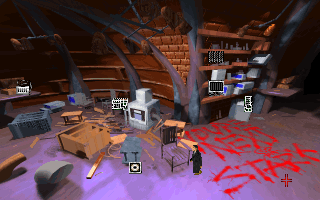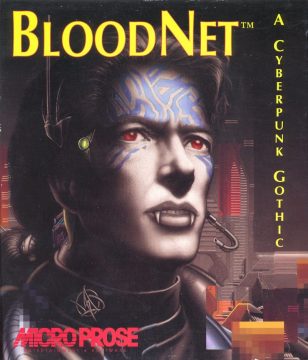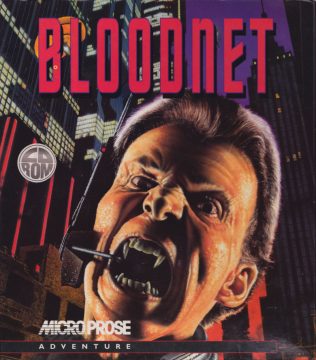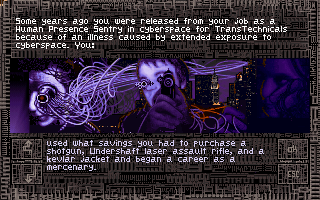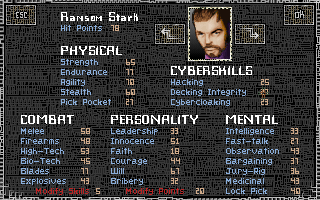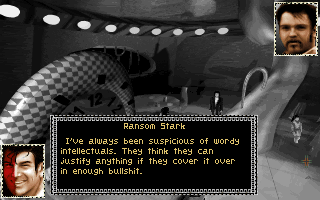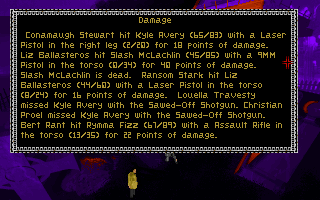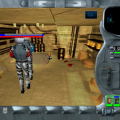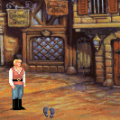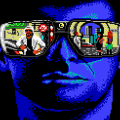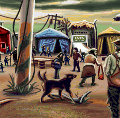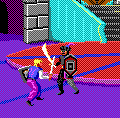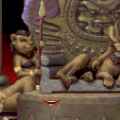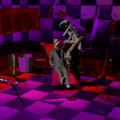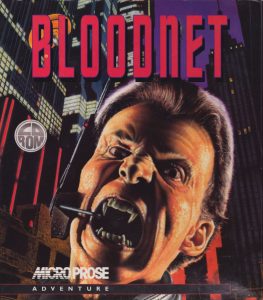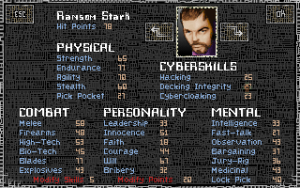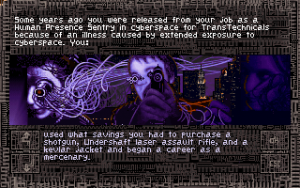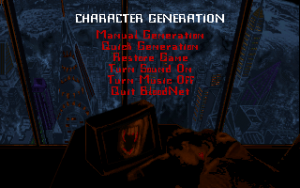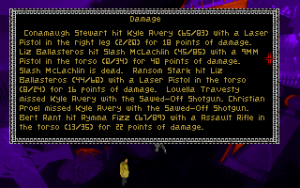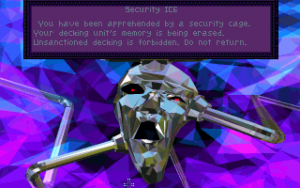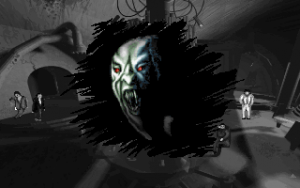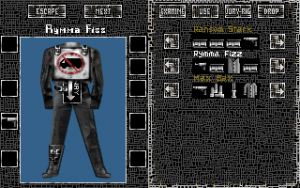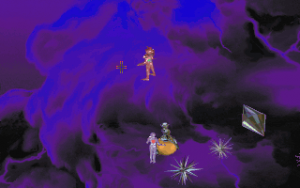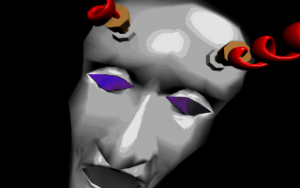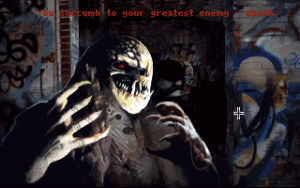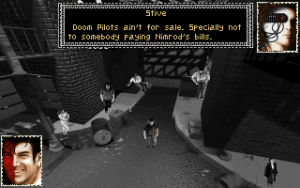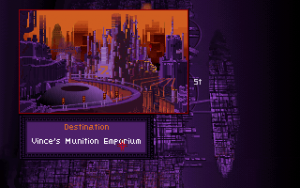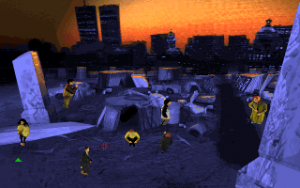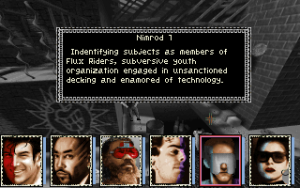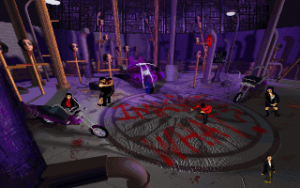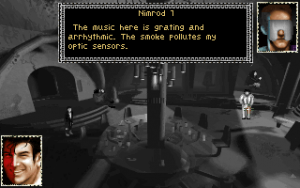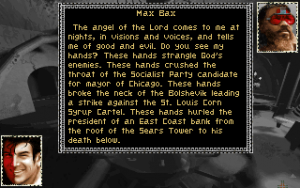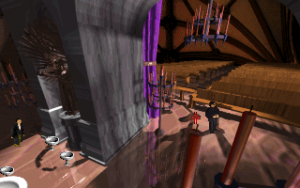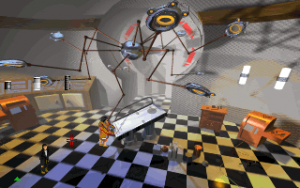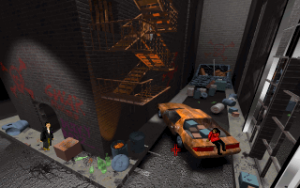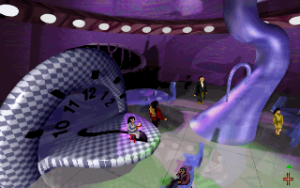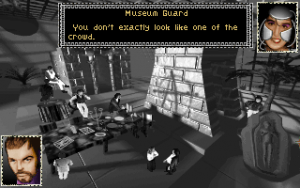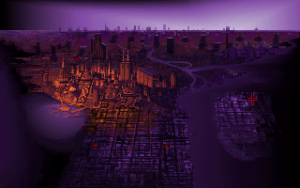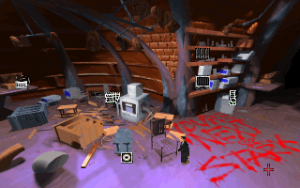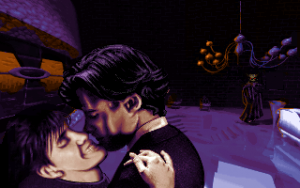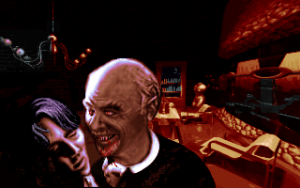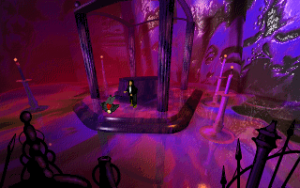BloodNet, a neo-futuristic RPG/point-and-click hybrid developed and published by Microprose, is something of an anomaly in the cyberpunk genre. It’s a game that takes itself extremely seriously despite its corny concept and execution, and demands that its players do the same. The whole notion of vampires in cyberspace isn’t a completely terrible one – there’s something there for sure, though arguably moreso in its tongue-in-cheek aspects. Mixing together early vampire and cyberpunk tropes almost sounds more like the basis of a canned Max Headroom episode than a video game. The only difference (besides being made a decade apart) is that the latter often knew when and how to laugh at itself, while BloodNet never even makes an attempt to.
Starting up BloodNet for the first time you may be surprised to find that in this point-and-click you have to virtually construct your character from scratch, determining their speciality and individual strengths. One way of doing this is through a rather amusing quiz that presents absurd cyberpunk dilemmas and asks how you proceed in solving them. The artwork featured here is moody, dark, and oddly compelling. If anything, the quiz presents some real promise, but it may just be the most enjoyment you’ll get out of the game.
If you’re not so inclined to answer the 20 questions it throws at you, you may opt instead for a “quick-generation”, which takes you directly to the stat-adjustment screen that comes after it anyway (however, this gives you a substantially weaker character, so it’s not at all recommended). On the largely monochrome interface you’re presented with literally dozens of skills, many of which you’ll later find out are actually useless. There’s no way of knowing from the beginning which are essential for progression, so deciding not to read-up beforehand and diving in blind will end up haunting you later.
But before making your character, the first cutscene of the game plays. And if any praise can be given to BloodNet‘s introduction, it’s that it establishes the whole game’s dialogue and narrative flawlessly within its (not-so-short) seven-minute timeframe. From the unrelenting text-dumps to the totally dead-inside tone, it’s all there and as dragged-out as it can possibly be.
The cutscene begins with large, barely-legible blood-red exposition sprawled across a black background – you are a man named Ransom Stark, it says. Standing around at your favorite bar, “The Abyss”, you’re approached by a vampiric sultress, and through a particularly droll conversation she offers you a job. If you’re playing the CD version, this sequence will come bundled with atrocious voice acting and hilariously extensive reverb, probably included to salvage whatever was possible out of the actors’ faulty deliveries. All other versions simply have text, and this is the preferable way to play, as for some weird reason you’re unable to play with both text and voice at once.
You accept the offered job and do as you’re instructed to do, but you ultimately get more than you bargained for when you’re bitten by a vampire named Abraham Van Helsing, who, aside from TransTechnicals (the organization that runs the city), is arguably the main antagonist of the game. The “scene” in which you’re turned into a vampire is laughable – it’s shot in stills, each fading in slowly one after another and each containing comically over-exaggerated poses and expressions by an actor who looks nothing like your chosen character. While this is happening, a scrambled mess of beepy MIDI music is pounding away. In a campy sense it sounds funny, but it’s played so seriously that it ends up just being monotonous.
Narrowly escaping from Van Helsing, you eventually find yourself in a so-called “subway”. There, your neural implant speaks to you, revealing it’s the only thing still keeping you partially human. This is used as a setup to one of BloodNet‘s primary mechanics, which could have been a neat idea if the game wasn’t so relentlessly non-linear. Over the course of your time playing, there is a “humanity” meter which will gradually tick down, and a “bloodlust” meter which will gradually go up. These levels have no overall effect on the narrative, and serve exclusively as gameplay parameters. The humanity meter is essentially a time limit for completing the game, because once it hits zero it’s game over. Bloodlust works in a similar fashion, only it can be decreased by biting NPCs and draining their blood. But be careful doing it, because not only does it lower your humanity, but biting a plot-dependant NPC for blood basically means the game’s over, too. That’s already a bit ridiculous, but it’s made all the worse by the game giving you absolutely no sign of who’s critical to the overall story and who’s not. This happens to be one of many, many situations in which you can accidentally make the game unwinnable without any indication of you doing so.
Littered around this first area you may have noticed small, monochromatic boxes and attempted to pick them up to no avail. You walk over to them and nothing happens. You click on them and nothing happens. You right-click on them and you find they’re able to be dragged all around the screen, which made walking to them pointless anyway. You give a box to Stark and wonder what you just picked up. You look for the inventory and a huge, clunky UI pops up when your mouse is hovered over the top of the screen. Four large and vague pictures are displayed and clicking one gives you more options that again mean nothing to the uninitiated. If you’re playing on DOS (the Amiga version has a more bearable soundtrack), the 8-second-loop of forcefully churned-out midi music has now looped half-a-hundred times. You find the options menu by pure luck, turn the music off, and now you’re playing the game in total silence. In the quiet, you have a sudden moment of introspection, and you find yourself asking – “Why am I playing this game, anyway?”
You’re likely to be playing BloodNet exclusively for its setting and atmosphere. The comparison can most easily be made to Hell: A Cyberpunk Thriller, which was released a year later and in a few instances actually references this game. They share somewhat similar visuals, but looking closely at the two Hell almost seems like a cheap knock-off. On a broader scale the parallel can also be made to the Shadowrun series, but BloodNet isn’t quite as grounded in familiar cyberpunk cliches. In fact, BloodNet manages to bend the subgenre’s conventions just enough to uphold a genuinely gritty and imposing mood. This is accomplished chiefly due to the game’s surreal, dreamlike slew of backgrounds and character portraits. There’s never anything resembling a consistent visual style, and while at times this comes off as embarrassing, at others it’s thoroughly engrossing and even lends a considerable amount of flavor. Some character portraits look like they were slapped together last-minute in MSPaint, while others utilize real photographs of people with some silly but rather impressive pixel-work overlayed. The backgrounds are equally as messy but fare better because that chaotic kind of aesthetic looks more or less intentional. Most environments are done in extremely primitive 3D, and they work surprisingly well. Because the proportions are so remarkably off and the sprites are so small, these grandiose locations gain the power to look huge and legitimately oppressive.
You’ll be very quick to find that the mega-corporation TransTechnicals runs the show, and because of that all the NPCs perpetually gloom in their own world of generic cyber-suffering. But aside from their cyber-problems, there’s really nothing else to the people you encounter. They stand around random locales doing zilch, speaking in paragraphs of overwritten text that probably could be distilled into one or two sentences. Usually they have a single quirk or tick that they broadcast on-repeat in-place of an actual personality (there’s a character called Benny Puzzle, who speaks exclusively in crossword puzzles). If the game wasn’t so dead-set serious these may have came off as funny, but are instead just lame and displeasing.
When someone isn’t rambling about doing some underhanded criminal work or talking about worthless cyberjunkie-life, they’re struggling to cope with something called “Hopkins-Brie Ontology Syndrome” – a condition in which you’re unable to differentiate between reality and cyberspace. The idea suggests some real potential, but nothing is ever done with it. And if it sounds straight out of a William Gibson novel, it’s probably because it is. Rather than borrow interesting concepts from seminal cyberpunk stories and allow them to develop on their own organically, the game instead chooses to rip off their edgy aspects without any true imagination or creativity.
It even mentions several authors by name at various points (besides Gibson, also Nietzsche, Orwell, Sterling, and Kafka), but the references come off like the game’s writers are trying to elevate themselves to their inspirations’ standard of quality. As if to say “because we’re like this, we’re as good as this”, which is obviously not the case. It’s clear BloodNet is definitely aspiring very hard to be something, and even more to be like the work it mimics, but it doesn’t have the cleverness or heart to pull off. There’s a prevailing impression at all times that the game is trying too much in a way that’s not at all endearing, doing so almost standoffishly, confident and unapologetic in its inflated cyber-ego.
The gameplay itself can be put under a similarly cocksure umbrella. Dozens and dozens of features are packed into the game (including the aforementioned bloodlust and humanity) and though the hefty ambitions are almost commendable, the sheer amount of them and the lack of skill to pull them off renders the game borderline unplayable. It’ll take multiple playthroughs to realize about 90% of the items the game offers are useless. The game has an odd “cyberspace” mode in which you float alongside messes of shapes to interact with others who are “decked-in”. There’s even a day-and-night cycle which causes different characters to show up in several locales, depending on the time.
But perhaps the worst of them is the combat, which is a required skill to master in order to complete the game. It’s often triggered when you least expect it, thrusting you into the thick of things immediately and not bothering with the slightest bit of a comprehensible tutorial. Menus and menus of needlessly complicated options are displayed, and a particularly appealing one, “quick-combat”, is a guaranteed game-over. Only knowing exactly what you need to do will keep you alive, and even then the system is just as time-consuming, arduous, and nonsensical. Having a powerful team is mandatory to get through these parts, but there are so many NPCS to recruit that it’s impossible to determine who’s actually viable until you’ve essentially tried them all. And in truly lazy fashion, no matter who you’ve chosen, all the character sprites become pretty much identical when the game switches over to combat mode.
Many of the mechanics sound somewhat promising in-concept, but they’re all executed dreadfully. It becomes incredibly commonplace to make progress (which is an already painstaking ordeal) only to have to start over because you accidently missed one insignificant and inexplicable detail that was necessary to proceed.
It’s made all the more worse by giving you no sense of direction whatsoever. Once the introduction to the game is over, you’re set free into an entirely open-world without any hint of where to go or what to do. The non-linearity is heinous to a point in which playing with a notebook and pen without a walkthrough will probably end with the notebook being filled by the game’s conclusion. Progress being unintuitive is a massive understatement – you either invest hours upon hours of research on how every individual component of the game works or you’ll get inevitably lost and eventually give up. Without any suitable quest-log there’s an an even greater layer of unintentional challenge, as side-quests can easily be picked up and disposed of all while having seemingly no effect at all on overall progression. The only attempt made by the game to organize the clutter is with a “dialogue-replay” option, which is self-explanatory, except there’s nothing to distinguish the dialogues from one another besides for the name of who you had it with. Yes, every individual conversation is listed as a separate entry, even the ones you had with the same person. By the time you’ve reached the end of the game you’re forced to sift through hundreds to find the one desired. Also, the very first encounter with Van Helsing in the introduction is omitted, which incidentally contains information needed to complete the game.
The glaring lack of overall storytelling becomes increasingly present the further in the game you go, too. Because the span of your playtime will be so littered with side-quests, the main plot only comes in small, rare and random increments. Usually it’s force-fed to you, and it’s hard to know what exactly is relevant and what’s not. Suffice to say, Ransom Stark’s story of struggling to maintain humanity in a cyberpunk dystopia is something that never gets any interesting developments or anything resembling an actual character arc.
Reaching the ending is exceedingly difficult already, but the humanity time limit instilled from the start makes it even more unforgivable. And regrettably there’s nothing worthwhile waiting for you there, either. The final boss laughably dies in one hit, and the subsequent ending is horrible, featuring an extremely abrupt and out-of-place twist that more or less insults you and the efforts you took to get there. The only thing it does give you is a hint to a sequel, and while one called BloodNet 2000 was being developed for some time, it was ultimately dropped.
BloodNet is a totally unfulfilling mess. It’s clear there’s something there, some real glimmers of potential shine through in the overwhelming heaps of trash on top, but to get there requires an ungodly amount of patience. The experience, although admirably atmospheric, can best be described as completely hollow. The dullness is overpowering, present in every drawn-out dialogue exchange, every failed mechanic, every unflinchingly blunt attempt at an interesting idea introduced one second and sacrificed the next to be cool. For every promising moment there are four or five sour ones. BloodNet should be remembered for the many unorthodox concepts it tried to pull off, and even more for how it utterly screwed them up.
